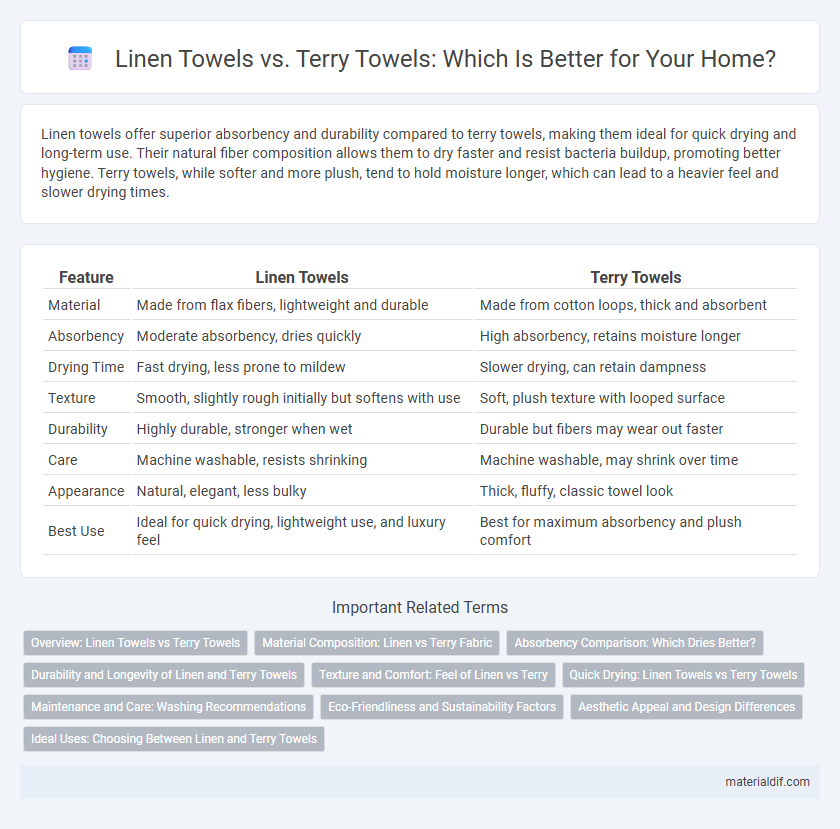Linen towels offer superior absorbency and durability compared to terry towels, making them ideal for quick drying and long-term use. Their natural fiber composition allows them to dry faster and resist bacteria buildup, promoting better hygiene. Terry towels, while softer and more plush, tend to hold moisture longer, which can lead to a heavier feel and slower drying times.
Table of Comparison
| Feature | Linen Towels | Terry Towels |
|---|---|---|
| Material | Made from flax fibers, lightweight and durable | Made from cotton loops, thick and absorbent |
| Absorbency | Moderate absorbency, dries quickly | High absorbency, retains moisture longer |
| Drying Time | Fast drying, less prone to mildew | Slower drying, can retain dampness |
| Texture | Smooth, slightly rough initially but softens with use | Soft, plush texture with looped surface |
| Durability | Highly durable, stronger when wet | Durable but fibers may wear out faster |
| Care | Machine washable, resists shrinking | Machine washable, may shrink over time |
| Appearance | Natural, elegant, less bulky | Thick, fluffy, classic towel look |
| Best Use | Ideal for quick drying, lightweight use, and luxury feel | Best for maximum absorbency and plush comfort |
Overview: Linen Towels vs Terry Towels
Linen towels, made from flax fibers, offer exceptional durability, quick-drying properties, and a natural antimicrobial effect, making them ideal for sensitive skin and eco-conscious users. In contrast, terry towels feature looped cotton fabric that provides superior absorbency and softness, excelling in water retention and plush comfort. Choosing between linen and terry towels depends on preferences for texture, drying speed, and maintenance requirements.
Material Composition: Linen vs Terry Fabric
Linen towels are crafted from flax fibers, resulting in a lightweight, highly breathable fabric that dries quickly and becomes softer with each wash. Terry towels are made from cotton loops, providing a thicker, more absorbent texture that traps moisture effectively but takes longer to dry. The natural strength and durability of linen make it ideal for long-term use, while terry fabric excels in plushness and initial absorbency.
Absorbency Comparison: Which Dries Better?
Linen towels exhibit superior absorbency due to their natural fiber structure, which allows them to soak up moisture quickly and dry faster than terry towels. Terry towels, made from looped cotton fibers, retain more water but tend to dry slower, increasing the chance of mildew. Linen's breathability and rapid drying time make it a more hygienic and efficient choice for drying.
Durability and Longevity of Linen and Terry Towels
Linen towels exhibit exceptional durability due to their strong flax fibers, which become softer and more absorbent over time without losing structural integrity. Terry towels, woven from cotton loops, provide plush texture but tend to wear out faster, with loops thinning and fibers weakening after frequent washes. The inherent resilience of linen fibers ensures linen towels maintain longevity far beyond typical terry towels, making them a superior investment for long-term use.
Texture and Comfort: Feel of Linen vs Terry
Linen towels offer a crisp, lightweight texture that becomes softer and more absorbent with use, providing a breathable and quick-drying experience. Terry towels feature a plush, looped pile that delivers a thicker, cushioned feel, ideal for maximum softness and absorbency. The natural fibers in linen create a slightly rougher touch initially, while terry cotton provides immediate comfort with its dense, fluffy surface.
Quick Drying: Linen Towels vs Terry Towels
Linen towels dry significantly faster than terry towels due to their natural fiber structure, which allows for better airflow and moisture evaporation. Terry towels, made from thicker cotton loops, tend to retain water longer, making them heavier and slower to dry. Quick-drying linen towels reduce the risk of mildew and are ideal for travel or humid environments.
Maintenance and Care: Washing Recommendations
Linen towels require gentle washing with mild detergent and should be air-dried or tumble-dried on low heat to maintain their strength and softness. Terry towels benefit from regular washing at higher temperatures to remove bacteria and absorbency buildup but should avoid fabric softeners that can reduce absorbency. Proper maintenance extends the lifespan of both towel types while preserving their unique textures and functional qualities.
Eco-Friendliness and Sustainability Factors
Linen towels, made from flax fibers, offer superior eco-friendliness due to their biodegradability and low water usage during cultivation compared to cotton-based terry towels. The durability and natural antimicrobial properties of linen reduce the frequency of replacement and washing, further minimizing environmental impact. Terry towels often require more energy-intensive processing and chemical treatments, making linen towels a more sustainable choice for eco-conscious consumers.
Aesthetic Appeal and Design Differences
Linen towels showcase a naturally textured weave that offers a rustic, elegant aesthetic, enhancing minimalist and spa-like bathroom designs. Terry towels feature a looped pile construction, providing a plush, voluminous look that adds softness and vibrant color depth to traditional or cozy settings. The contrasting textures between linen's smoothness and terry's fluffiness create distinct visual and tactile experiences tailored to varied design preferences.
Ideal Uses: Choosing Between Linen and Terry Towels
Linen towels excel in quick drying and breathability, making them ideal for beach trips and gym use where moisture management is crucial. Terry towels, with their thick loops and high absorbency, are perfect for bath time and home spa routines requiring softness and maximum water absorption. Selecting between linen and terry towels depends on the balance between lightweight durability and plush comfort tailored to your specific drying needs.
Linen Towels vs Terry Towels Infographic

 materialdif.com
materialdif.com